

Resounding success of ‘Black Panther’ franchise says little about the dubious state of Black film
When Marvel Studios released “Black Panther” in February 2018, it marked the first Marvel Cinematic Universe film to feature a Black superhero and star a predominantly Black cast.
Its estimated production budget was US$200 million, making it the first Black film – conventionally defined as a film that is directed by a Black director, features a Black cast, and focuses on some aspect of the Black experience – ever to receive that level of financial support.
As a scholar of media and Black popular culture, I was often asked to respond to the resounding success of that first “Black Panther” film, which had shattered expectations of its box office performance.
Would it lead to more big-budget Black films? Was its popularity an indication that the global marketplace – the real source of trepidation about the film’s potential – was finally ready to embrace Black-cast films?
Analysis of the world, from experts
With the release of the massively successful “Black Panther: Wakanda Forever” in November 2022, I expect those questions to reemerge.
Yet as I review the cinematic landscape between the original and its sequel, I am inclined to restate the answer I gave back in 2018: Assumptions should not be made about the state of Black film based on the success of the “Black Panther” franchise.
Reason for optimism
Prior to its release, the producers of “Black Panther” faced questions about whether there was a market for a Black blockbuster film, even one ensconced in the Marvel Cinematic Universe.
After all, since the Wesley Snipes-led “Blade” trilogy, which came out in the late-1990s and early 2000s, Black superhero films had experienced diminishing returns. There was one notable exception: the commercially successful, though heavily panned “Hancock” (2008), starring Will Smith.

Otherwise, Black superhero films such as “Catwoman” (2004) and “Sleight” (2016) either flopped or had a limited release.
Furthermore, until “Black Panther,” no Black film exceeded a $100 million budget, the average benchmark for modern Hollywood blockbusters.
Nonetheless, despite these early concerns, “Black Panther” earned the highest domestic gross, $700 million, of all films released in 2018, while earning $1.3 billion in worldwide gross, second only to “Avengers: Infinity War.”
“Black Panther” emerged at the tail end of what many industry experts considered to be a surprisingly successful run of Black films, which included the biopic “Hidden Figures” (2016) and the raunchy comedy “Girls Trip” (2017). Despite their modest budgets, they earned over $100 million apiece at the box office – $235 million and $140 million, respectively.
However, both films were mostly reliant on the domestic box office, especially the R-rated “Girls Trip,” which was only released in a handful of foreign markets. Conventional wisdom has long held that Black films will fail abroad. International distributors and studios typically ignore them during the presale process or at film festivals and markets, reasoning that Black films are too culturally specific – not only in terms of their Blackness, but also their Americanness.
Films like “Black Panther” and the Oscar winning “Moonlight” (2016), which earned more on the international market than the domestic market, certainly challenged those assumptions. It has yet to upend them.
Black films after ‘Black Panther’
What do those Black films released in theaters in the nearly five years between “Black Panther” and “Black Panther: Wakanda Forever” tell us about the former’s impact?
The simple answer is that the original “Black Panther” has had no discernible influence on industry practices whatsoever.
Since 2018, no other Black blockbuster has emerged, save for the sequel itself. Granted, Black filmmaker Ava DuVernay’s remake of “A Wrinkle in Time” (2018) reportedly cost an estimated $100 million; however, while Black actors portrayed the protagonist and a few other characters, the film features a multicultural ensemble cast – which, as scholars such as Mary Beltranhave pointed out, has become the primary strategy for achieving diversity in film.
Even if one were to include “A Wrinkle in Time,” the grand total of Black films with budgets exceeding $100 million is three, with the two “Black Panther” films being the others – all during an era in which there have been hundreds of mainstream films with budgets exceeding $100 million.
Otherwise, most of the Black films released in theaters between 2018 and 2022 typically were low budget by Hollywood standards – $3 million to $20 million in most cases – with only a handful, such as the 2021 Aretha Franklin biopic “Respect,” costing $50 million to 60 million.
Perhaps the most notable change has been the medium. Many Black films now appear on either cable networks that cater to a Black audience – namely Black Entertainment Television and, more recently, Lifetime – or on streaming services such as Netflix. Tyler Perry, the most popular and prolific Black filmmaker of the modern era, has released his latest films – “A Jazzman’s Blues” (2022), “A Madea Homecoming” (2022) and “A Fall from Grace” (2020) – directly to Netflix.
Furthermore, no other Black film has approached the financial success of “Black Panther.” Granted, several Black films have fared well at the box office, especially relative to their production costs. Foremost among them is Jordan Peele’s “Us” (2019), which cost an estimated $20 million, yet earned approximately $256 million worldwide despite its R rating and the fact that it was never released in China.
Whither Black film
Without question, large budgets and commercial success are not the only measures of a film’s value and significance.
As has historically been the case, Black film has managed to do more with less. The critical acclaim afforded to films such as “BlackKlansman” (2018), “If Beale Street Could Talk” (2019) and “King Richard” (2021) reflect this fact. All reflect trends in contemporary Black filmmaking – comedies, historical dramas and biopics abound, for instance – and were made for a fraction of the cost of both “Black Panther” films.
In truth, the zeal with which some cast “Black Panther” as a bellwether for Black films is part of continued haranguing over their viability, particularly after the #OscarsSoWhite movement that drew attention to the lack of diversity at the 2016 Academy Awards.
However, its positioning as a Disney property within Marvel’s transmedia storytelling effort makes it so atypical that its success — and that of its sequel — portends little about Black film.













